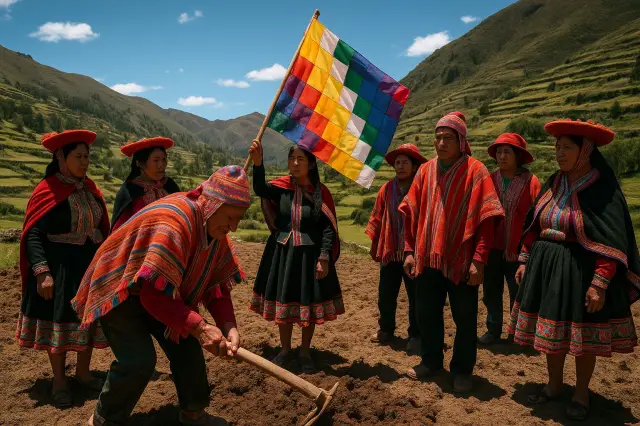The Andean calendar is a living manifestation of the ancestral worldview of the indigenous peoples of the Peruvian Andes. More than simply a measure of time, this calendar integrates astronomical, agricultural, and spiritual aspects, reflecting a deep connection with nature and its cycles. Through festivals and rituals, Andean communities honor Pachamama (Mother Earth) and Inti (Sun), ensuring harmony and balance in their lives.
You may be interested in reading: Peru Lunar Calendar 2025, phases and their impact on agriculture
Structure of the Andean Calendar
The Andean calendar is based on the observation of solar and lunar cycles, dividing the year into periods corresponding to agricultural phases and ritual celebrations. Traditionally, four main periods are recognized:

- Juyay Pacha (rest season): Corresponds to the time of rest of the earth, generally between June and August.
- Lapaka Pacha (preparation period): Period of land preparation and sowing, between September and November.
- Jallu Pacha (growing season): Time of crop growth, from December to February.
- Awti Pacha (harvest season): Time for harvest and gratitude, from March to May.
You may be interested in: holidays in Peru
Traditional Celebrations in the Andean Calendar
Each period of the Andean calendar is marked by festivities that strengthen the connection between community, nature, and the spiritual. Some of the most notable celebrations include:
Inti Raymi (Festival of the Sun)
Celebrated on June 24th, it coincides with the winter solstice in the southern hemisphere. It is one of the most important festivals, where people pay homage to Inti, giving thanks for the harvests, and requesting blessings for the new agricultural cycle.
Qoyllur Rit'i (Snow Star)
Held in May or June at the foot of the Ausangate snow-capped mountain, it's a pilgrimage that blends Catholic and Andean elements, where participants pay homage to the apus (mountain spirits) and Pachamama.
Pachamama Festival
During the month of August, especially on August 1st, rituals of gratitude to Mother Earth are performed, offerings known as "despachos" (spachos), which include food, coca leaves, and other symbolic items.
Ch'alla
A ritual of blessing and thanksgiving performed during the Andean Carnival in February. It involves sprinkling alcoholic beverages and decorating work tools, homes, and vehicles with streamers and flowers, requesting prosperity and protection.
Agricultural Times in the Andean Calendar
Agriculture is the central axis of Andean life, and the calendar guides agricultural activities according to natural cycles:
- Sowing: This takes place during the Lapaka Pacha, taking advantage of the season's rains to ensure crop growth.
- Harvest: It takes place at the Awti Pacha, where the fruits of labor are collected and rituals of gratitude are performed.
- Rest of the Earth: During Juyay Pacha, the earth rests, and maintenance and preparation activities are carried out for the next cycle.
Cultural and Spiritual Importance
The Andean calendar not only organizes agricultural activities but also strengthens the cultural and spiritual identity of communities. Through festivals and rituals, ancestral knowledge is passed on, community ties are strengthened, and the Andean worldview, which values reciprocity, balance, and harmony with nature, is kept alive.
The Andean calendar is a testament to the ancestral wisdom of Peru's indigenous peoples. Its understanding and practice continue to be fundamental to preserving the culture, identity, and well-being of Andean communities. Recognizing and valuing this legacy is essential to fostering sustainable development that respects nature and traditions.
Frequently Asked Questions
How does the Andean calendar relate to agriculture?
The Andean calendar guides agricultural activities based on natural cycles, ensuring that planting and harvesting take place at the most favorable times.
What does Ch'alla mean in the Andean context?
Ch'alla is a ritual of blessing and gratitude that takes place during the Andean carnival, where people sprinkle drinks and decorate their spaces with symbolic elements, requesting prosperity and protection.
Why is Inti Raymi important?
Inti Raymi is a festival that celebrates the winter solstice and pays homage to Inti, the Sun God, giving thanks for the harvests and requesting blessings for the new agricultural cycle.
What role does Pachamama play in the Andean calendar?
Pachamama, or Mother Earth, is central to the Andean worldview. Honor is paid to her and offerings are made to give thanks for the fruits received and to request her protection and fertility for the crops.
How is knowledge of the Andean calendar transmitted?
Knowledge of the Andean calendar is passed down from generation to generation through oral tradition, community practices, and participation in traditional rituals and festivals.
